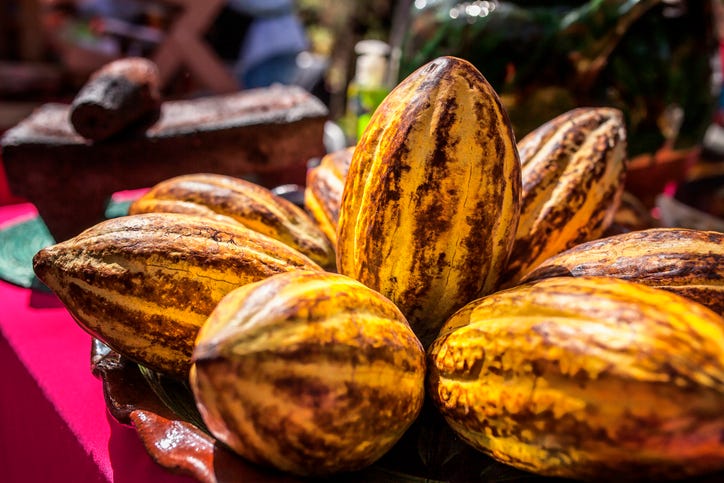Part 2: The Bitter-Sweet Numbers, Cocoa Production and Cocoa-Chocolate Industry Global Market Dynamics
Previously, we traced how cocoa became a pillar of five nations and noted the paradox of “big industry, small farmer gains.” We saw Ghana and Ivory Coast leading the world in cocoa, Cameroon and Nigeria holding steady as mid-level producers, and Indonesia rising rapidly outside Africa. We also raised a key question: Does the sheer volume of cocoa production translate to better lives for farmers? Now, in this second article, we shift focus to the hard numbers and market forces. I will compare current production volumes, yields, and quality across these countries, and dissect how global price swings and trade structures impact farmers. We will celebrate some achievements, record harvests, improved techniques, but also challenge the fetish for volume over value. As a cocoa farmer’s advocate, I ask: What is the use of being the No.1 or No.2 producer if your farmers still struggle to eat? We will examine data, backed by credible sources, and interpret it with a critical eye towards the interests of smallholders. (Grab a cup of hot chocolate, it’s about to get data-rich, yet deeply human.)
A smallholder farmer in Côte d’Ivoire spreads cocoa beans under the sun to dry. Ivory Coast and Ghana together produce over 60% of the world’s cocoa, yet many of these farmers live on the bitter side of a sweet global industry.
In the world of cocoa, one statistic often grabs headlines: market share. As of the mid-2020s, Côte d'Ivoire (Ivory Coast) remains the undisputed leader in cocoa production. The country produces around 2 million metric tonnes of cocoa beans annually in a typical year, accounting for roughly 40 - 45% of the global supply. Ghana follows as the second-largest producer, though at a significantly lower level. In recent good years, Ghana has produced about 800,000 to 1,000,000 tonnes (roughly 15–20% of the global supply). A vivid illustration: in the 2019/20 season, Ivory Coast harvested 2 15 million tonnes, while Ghana managed 800, 800,000 tonnes. That meant Ivory Coast alone supplied about 40% of the world's cocoa, versus Ghana's 17%. The gap is sizeable; the Ivory Coast's output is nearly three times that of Ghana, and it has been widening over the past four decades. Why? Mainly because Ivory Coast aggressively expanded its cocoa acreage, whereas Ghana plateaued due to land and policy constraints. Our other African players, Nigeria and Cameroon, each produce around 250 250,000–300 300,000 tonnes per year. This generally places them around the 4th or 5th position globally (Ecuador has recently entered the top ranks too, more on that shortly). Nigeria's output, for example, was 284,000 tonnes in 2023 according to FAO data, a solid figure but only ~14% of the Ivory Coast’s level.
Cameroon's production is similar; one recent estimate put Cameroon's 2023 output at 295,000 tonnes, making it the fifth-largest producer that year. Meanwhile, Indonesia, the giant from Asia, has seen its production fluctuate. After peaking at nearly 770,000 tonnes in 2018, Indonesia's annual output declined to about 667,000 tonnes by 2022 as disease and ageing farms took a toll. Still, at roughly 10–12% of the world's production, Indonesia remains the largest cocoa producer outside Africa. Depending on the year, Indonesia competes with Ecuador (Latin America's top producer) for the global #3 position. As of 2022/23, the Swiss Platform for Sustainable Cocoa noted that the Ivory Coast and Ghana combined made up 50% of global cocoa, Ecuador about 9%, with Indonesia cited as the largest Asian source. This highlights that our five focus countries collectively account for approximately three-quarters of the world's cocoa beans, a remarkable concentration of output from a few regions of West Africa and Southeast Asia.
However, being top dog in volume does not necessarily mean all is well on the ground. It’s worth noting how these production numbers can mask yearly volatility and underlying trends. For example, Ghana, despite its average of 800k–1M Metric tonnes, has experienced wild swings due to weather and disease. In the 2020/21 season, Ghana celebrated a record harvest of over 1,040,000 tonnes, only to see output crash to barely 650,000 tonnes in 2022/23 (almost 40% below target due to severe drought and soil fertility issues). Ivory Coast too faced a downturn in 2023/24, with excessive rains and disease leading to a rare production drop that rattled global markets. Such fluctuations highlight that being a leading producer comes with vulnerability to climate and agronomic challenges, a topic we will explore in Part 4.
Nigeria and Cameroon’s outputs have been comparatively steady (or stagnant, depending on one’s view), oscillating in a narrow band. This stagnation is often linked to limited replanting of old trees and a lack of farm investment post-liberalisation (more on that in Part 3). Indonesia’s slip from its peak reminds us that a meteoric rise can be followed by a plateau or decline if systemic issues (pests, farmer ageing, competition from other crops) aren’t addressed. Meanwhile, an emerging story is Ecuador: though not our focus country, it deserves mention that Ecuador’s production has surged (thanks to high-yield varieties like CCN-51), reaching 350,000–400,000 tonnes recently. Some sources put Ecuador as high as 9% of world share, which for the first time challenges Cameroon and Nigeria in the second tier. This Latin American growth is a reminder to West African and Asian producers that the global cocoa pie can be shared with new entrants if they are not careful. The world market is not static; while West Africa still utterly dominates (over 70% of global cocoa comes from Africa), other regions are increasing their slice.
Yields and Quality, Not
Keep reading with a 7-day free trial
Subscribe to Cocoa Diaries Newsletter to keep reading this post and get 7 days of free access to the full post archives.


